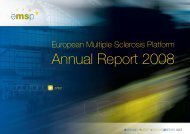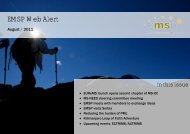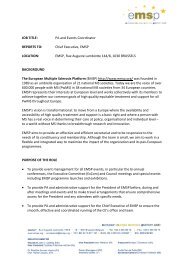Symptomatic Treatment of MS - European Multiple Sclerosis Platform
Symptomatic Treatment of MS - European Multiple Sclerosis Platform
Symptomatic Treatment of MS - European Multiple Sclerosis Platform
Create successful ePaper yourself
Turn your PDF publications into a flip-book with our unique Google optimized e-Paper software.
TRIGEMINAL NEURALGIA<br />
Drug treatment<br />
<strong>MS</strong>-associated TN is treated as any other type <strong>of</strong> TN. According to several controlled studies, carbamazepine<br />
is still the first line drug [Wiffen 2000]. Nevertheless even in sufficient dosage carbamazepine<br />
may cause a paradoxic increase <strong>of</strong> some <strong>MS</strong> symptoms in single patients [Ramsaransing 2000; Leandri<br />
2000]. Phenytoin, bacl<strong>of</strong>en [Fromm 1984], lamotrigine (up to 400 mg/d [Zakrzewska 1997]), gabapentin<br />
(up to 1600 mg [Solaro 2000; Yetimalar 2004]), topiramate (up to 300 mg/d [Solaro 2001]), oxcarbazepine<br />
and valproate are second-line drugs. Up to now no comparative drug trials have been published.<br />
Especially in emergency situations the efficacy <strong>of</strong> phenytoin has been proven since the drug can be<br />
injected i.v.. The efficacy <strong>of</strong> lamotrigine could be demonstrated even when combined with carbamazepine<br />
[Sindrup 2002]. Unfortunately, the dose <strong>of</strong> lamotrigine has to be increased very slowly<br />
precluding its rapid action. The prostaglandin E1-analogue misoprostol may <strong>of</strong>fer another treatment<br />
option for TN in <strong>MS</strong> patients (600 µg/d [DMKG Study Group 2003]).<br />
Surgical treatment<br />
Surgical interventions, like thermocoagulation and glycerol instillation into the Cavum Meckeli are widely<br />
accepted as second line therapies for TN [Patwardhan 2006]. Microvascular decompression <strong>of</strong> the trigeminal<br />
nerve has been performed successfully even in single <strong>MS</strong> patients [Broggi 1999], but in some <strong>of</strong> them<br />
complete pain relief could only be achieved after partial rhizotomy. On the contrary radiosurgery is a<br />
minimal invasive procedure and causes hypo- and dysaesthesias in only 10% <strong>of</strong> patients. 75% <strong>of</strong> patients<br />
will remain free <strong>of</strong> pain even after 3 years. Unfortunately there are no data on long time success compared<br />
to other surgical techniques [Kondziolka 2002]. Moreover high quality studies examining the efficacy <strong>of</strong><br />
these surgical techniques in <strong>MS</strong> patients are still lacking. In <strong>MS</strong> patients with TN, the achievement <strong>of</strong><br />
complete pain relief may require a higher number <strong>of</strong> surgical interventions to result in permanent relief<br />
when compared to TN <strong>of</strong> other origin [Cheng 2005].<br />
OTHER PAROXYSMAL SYMPTO<strong>MS</strong><br />
Paroxysmal paraesthesias and pain may occur spontaneously or are triggered by movement or posture<br />
within one part <strong>of</strong> an extremity. They will usually last up to several minutes.<br />
Carbamazepine is still the most important and most effective drug for the treatment <strong>of</strong> these paroxysmal<br />
symptoms and daily doses <strong>of</strong> 100 to 300 mg may lead to complete relief <strong>of</strong> the symptoms treated.<br />
Gabapentin (up to 1200 mg/d [Solaro 1998]), Lamotrigin (up to 400 mg/d [Cianchetti 1999]), phenytoin<br />
or valproate have as well been used successfully. Even with clonazepam and the sodium channel blocking<br />
agents lidocain and mexiletine several motor and sensory paroxysmal symptoms could be sufficiently<br />
reduced [Blakeley 2002; Sakurai 1999]).<br />
Patients with Uhth<strong>of</strong>f´s phenomenon should be told to avoid heat and to use cooling techniques. Moreover<br />
4-aminopyridine may be <strong>of</strong> some value [van Diemen 1992]. The treatment <strong>of</strong> choice in the rare facial<br />
hemispasm is the application <strong>of</strong> botulinumtoxin A once this becomes disabling [Cakmur 2002].<br />
31 E<strong>MS</strong>P, <strong>Symptomatic</strong> <strong>Treatment</strong> <strong>of</strong> <strong>Multiple</strong> <strong>Sclerosis</strong>, December 2006 - revised in April 2008






